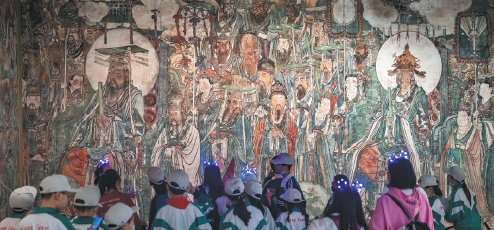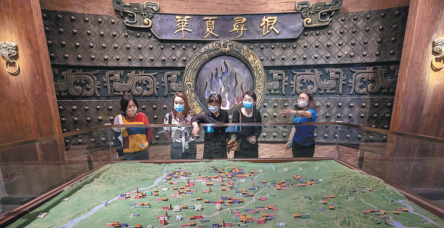Museum bringing Shanxi history to life
Updated: 2023-06-02

Students look at replica wall paintings at Yuncheng Museum. The original paintings, preserved in the city's Yongle Temple, represent the peak of China's Taoist mural art. [Photo by Yan Xin for China Daily]
Local institution presents province's culture, traditions for all to see
As one of the cradles of the Chinese civilization, the North China province of Shanxi is arousing the interest of researchers and ordinary tourists with its rich wealth of historical and cultural heritage.
A great number of museums in Shanxi, which house an abundance of historical relics and cultural heritage items, are where people develop a stronger understanding of the province's long history and its millennia-long culture and traditions.
Yuncheng Museum in the southwestern Shanxi city of Yuncheng is among these museums.
The museum now has a total of 35,000 exhibits, covering such fields as pottery, porcelain, bronze ware, stone carving, wall paintings and currencies, and reflecting a history dating back to the Paleolithic Period some 1.8 million years ago.
During their visits to the museum, China's central authorities endorsed its crucial role in showcasing China's human history of more than 1 million years, its cultural history of more than 10,000 years and its civilization history of more than 5,000 years.
They noted that the museum should be a vital venue for researchers to make explorations into the long history of China and identify the roots of Chinese civilization.
While calling for efficient preservation of exhibits, the central authorities also required the museum's management to make good use of these cultural legacies, invoking the general public's interest in and pride of the Chinese civilization by "bringing history to life".
Indeed, the management of Yuncheng Museum has put all their effort into bringing history to life by arranging exhibitions with multiple methods and modern tools.
At the main hall of the museum, for instance, there is a huge wall of sculpted reliefs, with themes relating to the historical stories and legends of Yuncheng.
The figures on the wall include Houji, who is said to have been a pioneer of the farming industry; Leizu, who is believed to have innovated silk production with silkworms; and Dayu, who is said to have led a campaign to curb a severe Yellow River flood some 4,000 years ago.

A sand table in Yuncheng Museum shows the major historical sites in the city. [Photo by Yan Xin for China Daily]
Wei Long is the head of the Yuncheng Center for Cultural Heritage Protection, an institution responsible for the operation of the museum. He has a deep understanding of the local history and the exhibits.
He said that all the figures on the relief wall are the forefathers of the Chinese nation and they all had associations with Yuncheng.
"Houji, for instance, was born in Yuncheng's Jishan county," Wei said. "His expertise in farming helped his tribe grow stronger and stand out against their rivals, which led to the establishment of the powerful Zhou Dynasty (c.11th century-256 BC)."
But the periods marked by these figures were not the beginning of Yuncheng's history, Wei said.
"In the village of Xihoudu, archaeologists discovered a site with relics identified as being 1.8 million years old, which might be proof of some of the earliest human activity in China.
"But the miraculous thing about it is not that long history. Some animal bones bore evidence of burning, which may signal proof of the earliest intentional use of fire in the world."
The official said the exhibits in Yuncheng Museum have great significance in historical research.
"It's widely known that China has a civilization of more than 5,000 years," Wei said. "However, the existence of the early periods of the civilization is mainly supported by legends."
He said the exhibits at the museum are offering material evidence for the specific periods, turning legends into real history.
Leizu, the pioneer of China's silk industry, for instance, is a legendary figure with no material proof to support her existence. It is said Yuncheng's Xiaxian county was the birthplace of Leizu.
"One of the exhibits at the museum is the stone-carved silkworm discovered at Xiaxian archaeological site, which was identified as a relic of 6,000 years ago," Wei said. "This indicates Yuncheng might be the source of China's silk industry."
To bring the exhibits to life, Wei said to cultivate a strong force of cultural heritage workers is the key.
He added that the tour guides at the museum are required to improve their competence by carefully studying the history not only relating to the exhibits but also from a comprehensive perspective.
Tour guide Yan Xiaojing, for example, is among the most popular at the museum.
When talking about the exhibits, she said there is something chaining them together. "That's the continuity of the local history," she said.
During a work day in May, she led a group of tourists to the exhibition wall, turning their attention to the reliefs of layers of pottery items.
"There are 10 layers of pottery items, just like where they are on the excavation site," Yan said.
In the bottommost layer are items identified as relics between 7,000 and 5,000 years ago, with styles identical to the Yangshao Culture, a Neolithic culture that existed extensively along the central Yellow River. "Then there are items on the upper layers according to the sequence of periods."
Yan said that the 10 layers correspond to almost every key stage of China's pottery industry development.
In addition to the professionalism of the cultural heritage workers, the museum is also using the latest technologies like virtual reality, augmented reality and holographic displays to present the details and stories of the exhibits, according to Zhou Wenquan, curator of Yuncheng Museum.
Zhang Haiying and Zhou Mingfei contributed to this story.



